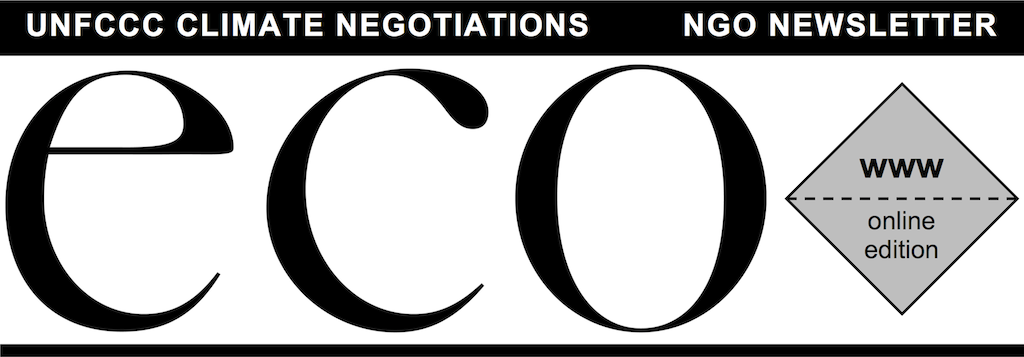Monthly Archive: March 2014
Negotiations are a Contact Sport
We’re pacifists here at ECO, but that doesn’t mean that we don’t have a soft spot for a good game of competitive sport. And just like the race to a low-carbon, climate-safe future, negotiations can be a good game too – of course we expect everyone to be good sportspeople and act in good faith.
ECO remembers our mothers warning – “games ain’t fun without no rules.” It’s time that everyone took that advice to heart. For the games to really get started on the comprehensive, fair and legally binding agreement the world needs, we need rules to guide the discussion. Those rules, under UN processes require Parties to form a “contact group” before formal negotiations can begin. ECO suggests this should happen before the half-time break of this Bonn session. In a contact group (open to observers, as the Philippines on behalf of the LMDC have suggested) Parties can tackle unfair proposals and score goals for ambitious and fair solutions.
It seems the crowd of countries cheering for a contact group is wide and growing to include African, Arab, BASIC, LMDC and some of the Pacific SIDS countries. So that leaves a question as to why the Europeans and Brollies, who usually love rules, seem determined to remain stuck in an eternal warm-up of informal consultations?
... Read more ...
Putting the Stale in Stalemate
![]()
While perusing some of the recent submissions to the ADP, ECO was overcome by an unshakable sense of déjà vu. It almost seemed as though some parties might have resubmitted some of their pre-Copenhagen submissions by mistake.
China’s submission for example contained no less than 14 references to the Bali Action Plan and process. Yet not a single one to the Durban Action Plan beyond the first 3 paragraphs. And, boy oh boy, did that call for 1% of GDP from developed countries for the Green Climate Fund bring back some memories.
China must be aware that simply recycling old submissions and repeating generic principles is not an effective negotiation tactic, especially when the ADP is moving to deeper water. It will neither strengthen your negotiating position vis-à-vis developed countries, nor help developing country peers who are looking to their “big brother” to help protect their interests and rights here. Why not use the many success stories and progress in China to leverage enhanced contributions at home and by others, and to facilitate a strong 2015 global deal?
Then there’s the US with its ongoing insistence on moving past binary categories, in spite of having failed to do its part during the period when those categories actually made sense.
... Read more ...
When Will Australia Increase Its Pre-2020 Ambition?
![]() The independent review by the Australian Government’s Climate Change Authority (CCA) is clear that Australia’s current 5% target is ‘woefully inadequate’. Instead the CCA has recommended that Australia’s fair share would be a target of 19% reduction of emissions below 2000 levels.
The independent review by the Australian Government’s Climate Change Authority (CCA) is clear that Australia’s current 5% target is ‘woefully inadequate’. Instead the CCA has recommended that Australia’s fair share would be a target of 19% reduction of emissions below 2000 levels.
So Australia – what will it be? Will you stay on ‘woefully inadequate’ or listen to what your own government advisories have to say and increase your ambition to at least 19% reduction in emissions? Because, let’s face it – as the OECD country with the highest per capita emissions, your weight is pretty hefty…
![]()
From Expert Meetings to Action Agendas
![]() Everyone has been waiting for today: the technical expert meetings will conclude with an entire session dedicated to “The Way Forward”. The last two days of presentations have demonstrated that there are many examples of successful ways to deliver clean renewable energy and the enormous potential for scaling up action. However, we haven’t even discussed how the ADP process will help to close the gigatonne gap between now and 2020. That’s what Workstream 2 is about still, right?
Everyone has been waiting for today: the technical expert meetings will conclude with an entire session dedicated to “The Way Forward”. The last two days of presentations have demonstrated that there are many examples of successful ways to deliver clean renewable energy and the enormous potential for scaling up action. However, we haven’t even discussed how the ADP process will help to close the gigatonne gap between now and 2020. That’s what Workstream 2 is about still, right?
ECO suggests that today’s session should focus on areas of common interest, barriers to scaling up renewable energy, and how the UNFCCC could spur on cooperative action and overcome the barriers. There are key questions to respond to tomorrow: what do we need the Technology Mechanism, the Standing Committee and the Green Climate Fund to do to realise the potential of renewable energy and energy efficiency? What decisions are needed in Lima to enable implementation?
UNFCCC institutions can be tasked to contribute in different ways. For example, the Technology Executive Committee could analyse renewable energy (RE) technologies highlighted by the Technology Needs Assessment process and synthesise lessons learned and best practices. The Task Force could also identify RE technology gaps or aid country planning by tracking the price trajectory of promising technologies.
... Read more ...
Adaptation Committee: All Hands on Deck
![]() Entering its second year of work, last weeks 5th meeting of the Adaptation Committee (AC) marks a crossroad for the group. It either has to move full steam ahead providing value to the international response on adaptation or continue to get stuck in the doldrums.
Entering its second year of work, last weeks 5th meeting of the Adaptation Committee (AC) marks a crossroad for the group. It either has to move full steam ahead providing value to the international response on adaptation or continue to get stuck in the doldrums.
Far from having the winds taken out of its sails, the AC achieved some important outcomes such as:
- The launch of the National Adaptation Plans (NAPs) Task Force which will bring different UNFCCC bodies together to support developing countries in formulating and implementing their NAPs and,
- A decision to engage with the Green Climate Fund and ADP Co-Chairs to improve coherence on adaptation related agenda items.
If these achievements strike you as rather mundane, there’s more! Two days ago ECO applauded the Technology Executive Committee (TEC) for moving towards greater transparency, so it should be acknowledged that the AC is already “ace” in that respect, by allowing observers active participation in their procedures. More UNFCCC bodies should follow suit.
![]()
Transparency of Support for Technology Transfer
![]() ECO is a fan of transparency, and we’re encouraged by the general agreement on the need for more of it on mitigation here in Bonn. Parties need to start considering the unique needs of transparency for support– particularly to enable the transfer of environmentally sound technologies.
ECO is a fan of transparency, and we’re encouraged by the general agreement on the need for more of it on mitigation here in Bonn. Parties need to start considering the unique needs of transparency for support– particularly to enable the transfer of environmentally sound technologies.
This discussion opens the opportunity to move beyond standard MRV questions. Instead, we can assess whether support ensures that all Parties are enabled to participate to their fullest extent? And are supported technologies respectful of communities and planetary boundaries? Such questions reflect the reality that full participation of developing countries is needed to ensure emissions reductions at the required scale, and that support is needed to enable this participation.
This would also be jeopardized by the introduction of technologies that put sustainable development at risk, threaten biodiversity or are undesirable from a cultural perspective though. How can these pitfalls be avoided? Complete transparency. To achieve this, there must be a comprehensive set of quantitative and qualitative indicators that can appropriately reflect relevant concerns. These should include indicators to measure the participation of countries in the full variety of technology transfer arrangements from bi- to multilateral or business-to-business and the list goes on.
Transparency also demands the establishment of a mechanism that stakeholders can demand redress in the case that climate action is impacting their property or livelihood.
... Read more ...
Some memos for you all today…
Memo to all countries
In Warsaw, Parties agreed to kick-start their domestic preparations to develop post-2020 commitments. While a few brave countries will present on their progress (see corresponding box), what ECO would like to know from all countries is:
- Has your government started a process to prepare and submit ambitious targets by Lima and very latest by March 2015? Will your government meet that deadline? If not, then what needs to be done? Are you doing it? If not, start now!
- What is the science reference used to set your targets, Is it the IPCC’s 5th Assessment report? Do you aim to stay below 1,5 or 2 degrees Celsius? What likelihood are you using in your assessment of what is required by science? Do you want 90% certainty to be on the safe side, or is it 50/50 adequate? What indicators do you use when sharing (the) effort between countries?
- What about finance for adaptation and mitigation, technology, capacity building and loss and damage? Do you have a process for increasing the level of action, finance, and support for technology transfer?
- Are you planning to provide transparency on what your target is made of? Are you planning to include information that allows it to be quantified and compared as well as assessed against adequacy and equity?
... Read more ...
The race to Lima is on
The sun is shining, the starting pistol has been fired, and the race for a draft negotiating text for Lima is on. With the negotiations as the racecourse, we have the Parties running towards the finish line, only there are four key hurdles that they all face: the convention, contributions, contact groups and elements.
The convention is a hurdle that will come up time and time again, but the exact shape and size that it will take remains unknown. For some Parties this is the key hurdle to clear, even though some may want to avoid it all together. For most though, this is an important hurdle that just needs more flexibility. It looks like we all might need a little more training and preparation for Parties on this one.
All Parties want the same thing on contributions – more progress on what the information requirements are. With a pause for breathe, and with a fleeting clap of encouragement from onlookers, the EU has set a good example by kick-starting their preparations already. They’ve still got a ways to go if they want to set a strong and steady pace though. We’ll be tuning in to today’s workshop to hear more on how this is progressing.
... Read more ...

